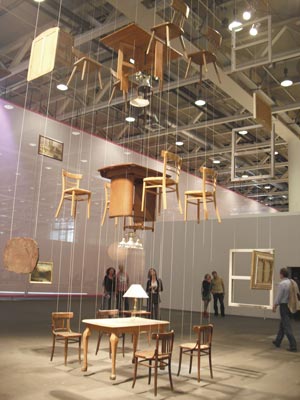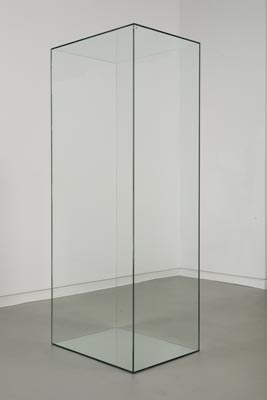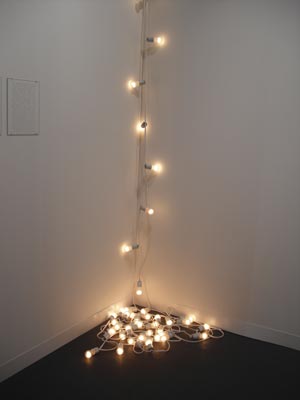“Collectors expect–and find–the best”, is the headline of one of the articles published by The Art Newspaper (Art Basel daily edition) during the Art Basel Fair in its 43rd edition. The phrase cannot be more illustrative of both facets this fair perfectly organizes and which guarantee its success and high prestige. On the one hand, the participation of worldwide elite collecting (it is the paradise of great collectors, who are capable of investing true fortunes in artworks), and on the other hand, the high professionalism and prestige of the participating galleries and the artists they represent and exhibit. This way, Art Basel reasserts itself as the most important modern and contemporary art fair in the world and the most outstanding meeting for the art market having surpassed all records: 65.000 visitors; more than 300 galleries from 36 countries; 2.500 artists; sales that were already up by 30% of the pieces when the fair had barely begun. Figures which go along with the interest for developing its diverse sectors (Art Unlimited, Art Statements, Art Feature), film showings (Art Film), talks, panels (Art Salon) and the invitation to discover city neighborhoods through art (Art Parcours) displaying a really intense and unique dynamic. Art and its market gather at a city that, as every year, transforms into the mecca of private sales in a globalized commerce that does not seem to know about the crisis.
 Thus, after a rigorous selection process that is still kept in all categories, the leading galleries in Latin American art attended the event that gathered the “most influential and innovative 300 galleries on the planet”: four from Brazil (Galeria Fortes Vilaça, Galeria Millan and Galeria Luisa Strina from São Paulo and A Gentil Carioca from Rio de Janeiro); three from Mexico (Kurimanzutto, Galería OMR and Proyectos Monclova) and one from Argentina, the Bonaerense art gallery Ruth Benzacar). Without becoming one of the major components in proportion to the rest of the artists and galleries, as it usually happens in the Miami art show (about thirty Latin American galleries in the year 2001 and a score of them in 2010), Basil still gathers together a considerable representation of Latin American and Caribbean art, with fundamental names and figures like Fernando Botero, Wilfredo Lam, Roberto Matta, Lucio Fontana, Waltercio Caldas, Félix González-Torres, Ana Mendieta, Doris Salcedo, among others. It is an art widely inserted in the international scene, and about which “it is very difficult to generalize”, just like Basil Art director Marc Spiegler states, underlining that “Latin American art is as diverse as art in the rest of the world”.
Thus, after a rigorous selection process that is still kept in all categories, the leading galleries in Latin American art attended the event that gathered the “most influential and innovative 300 galleries on the planet”: four from Brazil (Galeria Fortes Vilaça, Galeria Millan and Galeria Luisa Strina from São Paulo and A Gentil Carioca from Rio de Janeiro); three from Mexico (Kurimanzutto, Galería OMR and Proyectos Monclova) and one from Argentina, the Bonaerense art gallery Ruth Benzacar). Without becoming one of the major components in proportion to the rest of the artists and galleries, as it usually happens in the Miami art show (about thirty Latin American galleries in the year 2001 and a score of them in 2010), Basil still gathers together a considerable representation of Latin American and Caribbean art, with fundamental names and figures like Fernando Botero, Wilfredo Lam, Roberto Matta, Lucio Fontana, Waltercio Caldas, Félix González-Torres, Ana Mendieta, Doris Salcedo, among others. It is an art widely inserted in the international scene, and about which “it is very difficult to generalize”, just like Basil Art director Marc Spiegler states, underlining that “Latin American art is as diverse as art in the rest of the world”.
A large installation by Mexican Damián Ortega marked the main entrance of the Art Unlimited sector, curated this year by Gianni Jetzer (director of the Swiss Institute, New York) and presented as an “unlimited” program for huge artworks. TitledArchitecture without Architects (2010), it offers one of his classic deconstructions focused on the convergence of architecture, sculpture and spatial analysis. Chairs, tables and architectural elements floating in the air, defying gravity, welcomed visitors inviting them to lose themselves in a universe of impressions. This artwork was the focal point of his 2010’s exhibition at the Barbican Center in London, and here it is an example to confirm his ability to transform the ordinary into extraordinary, and to give the spectator the assertion of a new vision of private, quotidian space.
Among the themes and perspectives contributed by the selected projects for the Art Statements sector –which is dedicated to present the work of emerging artists–, the work by young Mexican artist Edgardo Aragón (Proyectos Monclova, Mexico D.F.) stands out. La Trampa (The Trap), 2011, is a three-channel video installation that documents the life and death of a remote town in Oaxaca, southern Mexico, established around a clandestine landing strip for transporting marijuana during the seventies and eighties. The video installation combines several film shots superimposing views of the landing attempts of one last plane, which were recreated by the artist; remains of the original plane on the desertic landscape; and a local trio performing a folk song that tells the story of the plane, burned by the drug dealers to avoid being captured by the federal police. All from the disquieting contrast among the desolation of the images, the harshness of the story told and the apparent harmony of the song known from word of mouth by the town inhabitants. Two Dutch galleries completed the Latin American participation in this sector that has promoted young artists since 1996: Diana Stigter (Amsterdam), with an objectual installation by the Argentinean Amalia Pica (based in London) that talks about the insufficiency of standardized communication systems; and Upstream Gallery (Amsterdam), presenting animations and videos by Chilean Cristóbal León and Joaquín Cociña.
Many international galleries incorporate or keep working with Caribbean and/or Latin American artists in the wake of the interest that their creations stir up (discoursive solidness of the proposals) and of the stability they maintain at the market level –even despite the preference for a more classic kind of art on the part of many buyers, or the drive of, for example, Asian or Eastern European contexts. Hence, besides the Latin American galleries present at the fair (a total of eight), a good deal of the art representation from this region comes from exhibition spaces in other parts of the world, among which we can highlight Parisian Galerie Chantal Crousel with artworks by Jennifer Allora & Guillermo Calzadilla, Abraham Cruzvillegas and Gabriel Orozco; Galeria Joan Prats in Barcelona with the series Der Biologe, 2012, splendid drawings, ink on paper, by Fernando Bryce and oil paintings by Enrique Martínez Celaya; Edwynn Houk Gallery (Zurich-New York) with the piece Irises (from Pictures of Magazines) 2004, by Vik Muniz; and Galerie Peter Kilchmann (Switzerland) with important works by Teresa Margolles, Los Carpinteros (The Carpenters), Javier Téllez, Francis Alÿs, Jorge Macchi and Melanie Smith.
The Galerie Peter Kilchmann included –for the first time– the work by the collective Los Carpinteros (Marco Antonio Castillo and Dagoberto Rodríguez): a series of watercolors on paper and the piece Conga Ceniza, 2012, a black conga drum, a chrome-plated percussion instrument, that seems to be molten on the floor as if it had been exposed to high temperatures or pressure (a “fusion”), being at the same time a metaphor for the “meltdown” of individuals in oppressed societies. As in many artworks by this collective, the planned functionality of the object has fallen through, the fine line between reality and unreality has been subverted, and spectators find themselves disoriented or open to other forms of association. The piece is part of a series of “melted musical instruments” that plays with some of the most important components of the Cuban idiosyncrasy: the music, the mockery or teasing, and the tropical climate and it alludes to the cathartic effect that music and dance have on the average Cuban, diluting serious problems to the rhythm of the drums and ending up turned into festivity.
 We find another vision coming from the author’s own references in a specific context in the artwork by Carlos Garaicoa, which could be seen at the Galleria Continua stand (Italy); and in an individual exhibition by the artist titled La ciudad vista desde la mesa de casa (A City View from the Table of My House) in the Kunsthaus Baselland, as part of the VIP program at the fair. The show allowed an interesting visit along the last stages of his work, including recent pieces like the series Lo viejo y lo nuevo (The Old and the New) 2010, El árbol de la abundancia (Tree of Abundance) 2011, or Prêt-a-porter 2011, all of which emphasized his critical approach towards the contemporary sociopolitical reality. At the fair, a series of small photographs of buildings that lay in ruins in the city of Havana, printed on bone plates, especially stood out by the hand of Galleria Continua. In spite of being about the current appearance of emblematic zones closely linked to the popular life, the treatment (ochre, yellowish tone) of the images accentuated their run-down conditions, which gave the impression of being standing up before an ancient postcard or a sort of historical documentation of important scenes in the city.
We find another vision coming from the author’s own references in a specific context in the artwork by Carlos Garaicoa, which could be seen at the Galleria Continua stand (Italy); and in an individual exhibition by the artist titled La ciudad vista desde la mesa de casa (A City View from the Table of My House) in the Kunsthaus Baselland, as part of the VIP program at the fair. The show allowed an interesting visit along the last stages of his work, including recent pieces like the series Lo viejo y lo nuevo (The Old and the New) 2010, El árbol de la abundancia (Tree of Abundance) 2011, or Prêt-a-porter 2011, all of which emphasized his critical approach towards the contemporary sociopolitical reality. At the fair, a series of small photographs of buildings that lay in ruins in the city of Havana, printed on bone plates, especially stood out by the hand of Galleria Continua. In spite of being about the current appearance of emblematic zones closely linked to the popular life, the treatment (ochre, yellowish tone) of the images accentuated their run-down conditions, which gave the impression of being standing up before an ancient postcard or a sort of historical documentation of important scenes in the city.
Another photographic vision was offered by Marian Goodman Gallery (New York), where we could see a set of four recent photographs by Gabriel Orozco, representing snapshots of objects and situations the artist finds in the streets and whose meaning is reinforced by the titles: Jerga cubana (Cuban Jargon) shows the typical mop used to clean Cuban homes; Cubo Amarillo (Yellow Bucket), an object with such characteristics in the middle of the street; Orange line, an orange rind drawing a spiral; and Manhole Cover, a photograph taken of just that. Images where he preserves the objectual level of the artwork without the need to move, isolate and decontextualize, and which at the same time allow him to find again another basic key in his language, that is, being a cut, an interruption in time and space. In keeping with Orozco’s poetics, we find the piece Hero (2011) by Wilfredo Prieto, presented by Annet Gelink Gallery, Amsterdam; a big translucent rectangle, an empty structure, that activated key concepts in his speech like: presence and absence, empty and full, container and contents.
The Belgian Galerie Jan Mot is especially worthy of mention, where artworks and creators from diverse generations and contexts, but similar interests, established a dialogue. Thus, we found artworks by Argentinean David Lamelas, one of the pioneers of conceptual art from the sixties and seventies, Marcel Broodthaers and Ian Wilson together with the work by younger artists like Tris Vonna-Mitchell and Mario García Torres, who is the author of the installation An Approximation to “9 at Castelli” (My Own Experiences, Findings and Happenstances), 2011, which comes from the research and re-creation of exhibition 9 at Leo Castelli held in New York. Unlike other works by the artist that take up again little known events, the exhibition housed in the Castelli Warehouse at the end of 1968 did not go unnoticed, but became a paradigmatic moment in the conceptual art history. Organized by Robert Morris barely two months after the publication of his Anti Form essay, it put together artworks by Giovanni Anselmo, William Bollinger, Eva Hesse, Stephen Kaltenbach, Bruce Nauman, Alan Saret, Richard Serra, Keith Sonnier and Gilberto Zorio. However, the artist’s interest aroused from the contradictory information surrounding the exhibition, the little attention it got at the time and its almost non-existing documentation. This lack of clarity invited him to fill in the blanks and to regenerate the show, building it new significance.
The Esther Schipper gallery (Berlin) bet on the artwork by Mexican Gabriel Kuri with two of his typical collages and a sculptural installation. As several of his compatriots, Kuri was widely represented at the fair: Kam Yuen Group, 2011 (receipts printed on hand-woven wool Gobelins), could be seen at the Kurimanzutto Gallery, a space that also included works by Gabriel Sierra, Orozco, Damián Ortega and Allora & Calzadilla. The proposals presented by Fortes Vilaça equally stand out with photographs by Mauro Restiffe, emblematic sculptures by Ernesto Neto, and the piece Estantería (Bookcase), 2010 by Los Carpinteros (of which three editions were sold as soon as the fair was opened); and the same happens with those presented by A Gentil Carioca (Rio de Janeiro), with a project curated for the Art Feature sector where the artists José Bento, Lourival Cuquinha and Rodrigo Torres used the symbols of money/gold to comment on global economies and question the value of money.
 The Latin American and Caribbean participation was complemented with four of the fourteen projects integrating the Art Parcours sector this year –which invited to go round the old St. Johann neighborhood on the banks of the Rhine. Los Carpinteros, with the work 150 people, 2012, dressed with handcrafted clothes each and every one of the chairs at Prediger Church; Pedro Reyes, with his video installation Baby Marx (2008 – present), based on the debate of the 19th Century between socialism and capitalism, with Karl Marx and Adam Smith as leading characters in a puppet show that was turned here into a life show; Abraham Cruzvillegas, with the film Autoconstrucción (Self-construction), 2009; and Eduardo Basualdo with the installation L’Innombrable, 2012.
The Latin American and Caribbean participation was complemented with four of the fourteen projects integrating the Art Parcours sector this year –which invited to go round the old St. Johann neighborhood on the banks of the Rhine. Los Carpinteros, with the work 150 people, 2012, dressed with handcrafted clothes each and every one of the chairs at Prediger Church; Pedro Reyes, with his video installation Baby Marx (2008 – present), based on the debate of the 19th Century between socialism and capitalism, with Karl Marx and Adam Smith as leading characters in a puppet show that was turned here into a life show; Abraham Cruzvillegas, with the film Autoconstrucción (Self-construction), 2009; and Eduardo Basualdo with the installation L’Innombrable, 2012.
This way, Art Basel, the great art showcase created in 1970, gathered together artworks that went from exploring the mechanisms underlying the construction of the contemporary artistic discourse to the interest on the individual and the current socioeconomic reality, as part of an international dialogue among creators. Artists globalize, as well as fairs, sites where great fortunes meet the emergence of new markets. This cosmopolitanism has been one of the keys of Art Basel, a fair that has evolved worldwide with the arrival of emerging countries, be it through gallerists or collectors, and has even decided to expand to the Asian market opening its third venue in Hong Kong in the spring of 2013. At a time in which, for many, art is seen as “a great investment, as a safe shelter in the times of financial crisis we are living in”, let us hope the sales records are kept, and that –in spite of the crisis–, not only the financial elite keeps investing in contemporary art, but also all those interested people, institutions or entities.
Related Publications

How Harumi Yamaguchi invented the modern woman in Japan
March 16, 2022












